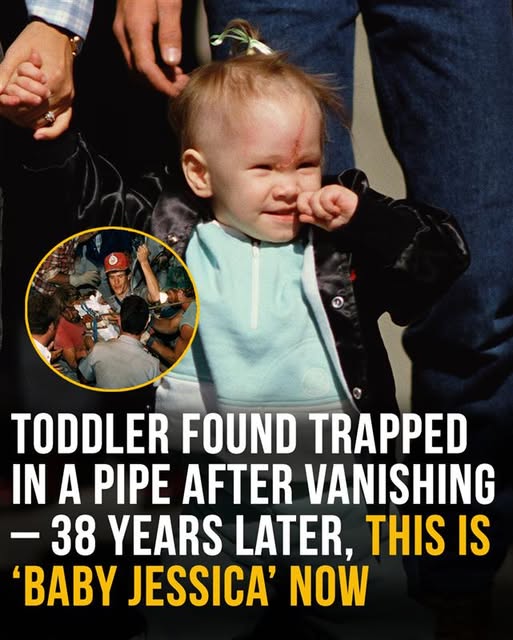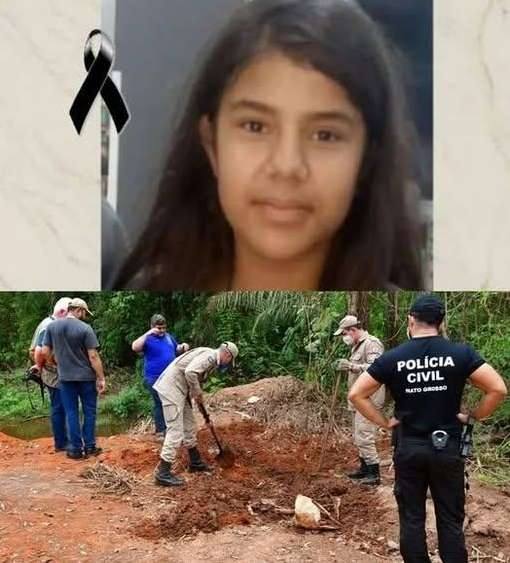There are stories that fade with time, and then there are stories that become permanently etched into a nation’s memory. Stories so dramatic, so emotionally charged, and so raw in their humanity that they transcend their moment and remain alive decades later.The extraordinary tale of Jessica McClure Morales, better known to millions simply as “Baby Jessica,” is one of those rare, unforgettable stories. In 1987, America was thrust into a moment of unified hope and fear as the entire country watched rescue crews fight to save a toddler trapped deep underground.Nearly four decades later, the legacy of that event continues to shape Jessica’s life, her family, and the way Americans remember moments of collective courage. This is not just a recounting of a historic accident — it is the intimate human journey of a girl who survived the impossible and then grew into a woman defined not by trauma, but by resilience, grace, and simple everyday strength.
A Quiet Texas Morning That Changed Everything
Midland, Texas was an ordinary place in the fall of 1987 — quiet streets, warm sunlight, and the kind of small-town rhythm where neighbors knew each other by name. On the morning of October 14, 18-month-old Jessica was playing like any other toddler: innocent, carefree, and blissfully unaware of danger.

Her mother, Cissy, was watching from nearby as Jessica and several other children wandered around the backyard of her aunt’s home. The yard was familiar. Safe. Routine.Until suddenly… it wasn’t.
Jessica disappeared.At first, it didn’t make sense. One moment she was there — the next, gone. Panic began to rise. Everyone started calling her name, looking under bushes, behind toys, inside the house.Then came the horrifying discovery:
Jessica hadn’t wandered off. She had fallen through the opening of an abandoned, narrow well shaft hidden in the backyard.It was only 8 inches wide — barely large enough for a toddler’s body to slip through. And she had fallen 22 feet straight down.
Cissy’s voice shook when she later recalled the moment: “I didn’t know what to do. I just ran in and called the police. They were there within three minutes, but it felt like a lifetime.”In that instant, a mother’s worst nightmare had become reality.
The Race Against Time Begins
Within minutes, first responders arrived. Police, firefighters, and emergency medical teams began surrounding the backyard, but it took only a quick look into the narrow hole for the truth to hit them:This would not be a simple rescue.
This was a mission that required:
- geologists
- drilling engineers
- mining experts
- trauma doctors
- volunteers
- and extraordinary creativity
Detective Andy Glasscock, one of the first officers on scene, leaned over the opening and called down into the darkness:
“I called the baby’s name three or four times and didn’t hear anything. Finally, I got a cry in response.”
That faint cry became the heartbeat of the rescue effort.
A Nation Watches as Hope Hangs by a Thread
Within hours, news cameras gathered. Local reporters became national ones.
The story swept across America like wildfire — a toddler trapped underground, her cries echoing up from the earth.Live broadcasts ran 24 hours a day.
People skipped work. Churches held prayer vigils. Children wrote letters.
Strangers gathered in living rooms, waiting for any update.And America waited for a miracle.
A Rescue Unlike Anything Seen Before
Experts quickly realized that trying to pull Jessica straight up through the narrow shaft was impossible — she was stuck, and forcing her upward risked severe injury. So they came up with a daring plan:Drill a separate shaft parallel to the well, then cut through horizontally to reach her. But there was one problem.
The ground beneath the yard was made of rock so hard that drilling equipment burned out constantly. Workers had to stop again and again to reposition machinery, replace drill bits, and re-evaluate the angle of approach.Meanwhile, Jessica was trapped in a space no larger than her own body — unable to move, unable to eat, unable to drink.
Through microphones, rescuers could hear her crying, whimpering… and sometimes singing to comfort herself. One of the songs she sang was “Winnie-the-Pooh,” a detail that would forever break America’s heart.
Emotions Run High as Hours Turn Into Days
The rescue effort intended to take a few hours quickly turned into 20 hours… then 30… then 40.By the time 48 hours had passed, emotions were fraying.
Workers were exhausted.
Cameras captured rescuers breaking down in tears.
Parents across the country held their children a little tighter that night.Every minute mattered. Jessica was without food, without water, and in a cold, dark space with limited oxygen.
Yet somehow… she kept fighting.
The Final Push: A Battle Against the Earth Itself
After almost 60 relentless hours, rescuers finally broke through the last layer of rock. One man, lowered into the new shaft, carefully reached toward Jessica.
Millions watched on live television as rescue workers emerged… holding the tiny, dirt-covered, terrified toddler in their arms.
America erupted in tears, applause, and disbelief.
Jessica was alive.
Doctors rushed her to the hospital. Her right foot had suffered severe injury due to lack of circulation, and she bore cuts, bruises, and trauma — but she was breathing.
The miracle had happened.
Baby Jessica Becomes a Symbol of Hope
Across the country, viewers celebrated the triumph.
Strangers who didn’t know each other hugged in grocery stores.
Flags were raised.
Church bells rang.
A trust fund was created for Jessica — donations poured in from all around the world, eventually totaling $1.2 million.
Her rescue became one of the most iconic television moments of the 20th century.
But for Jessica, the road ahead would be long, complicated, and at times painful.
Growing Up in the Shadow of a National Legend
Though she has no memory of the event itself, Jessica learned about her rescue at age four when she watched it on Rescue 911.
She remembered crying — overwhelmed without understanding why — until her stepmother told her:
“You do realize that is about you?”
Her father had planned to tell her when she was older, but the television broadcast reached her first.
As she grew up, people often recognized her as “Baby Jessica.”
Some children at school teased her.
Adults viewed her with curiosity, sometimes awe.
But Jessica always handled it with quiet strength.
Her Body Carried the Scars, But Her Spirit Didn’t Break
Jessica underwent 15 surgeries in the years after the accident:
- A surgical reconstruction of her right foot, which had developed gangrene
- Treatment for multiple cuts and abrasions
- Physical therapy
- Long-term healing
She still carries a faint scar on her forehead — almost invisible now — and occasional pain in her foot.
Yet she remains remarkably grounded about the ordeal.
She has said again and again:
“It was a miracle, and I believe God had a hand in it.”
A Family of Her Own — and a Life of Quiet Strength
Today, Jessica lives a humble, peaceful life in rural Texas with her husband Danny, whom she married in 2006.
Danny vividly remembers the day she was rescued — he was 13, at a football game, when the announcer paused everything to share the news.
“They stopped the whole game to say, ‘Baby Jessica has been rescued.’ It was pretty cool.”
Together they raised two children, Simon and Sheyenne, and now Jessica is a grandmother as well, to Emiliano and Nolan.
She works in education and horticulture, far from the cameras that once surrounded her.
She chooses simplicity. Privacy. Peace.
Because she lived through enough drama before she was even two years old.
The Trust Fund: A Gift From the World, Lost to Time
The $1.2 million trust fund created for Jessica was a symbol of love from strangers everywhere.
But when the 2008 stock market crashed, much of that money vanished.
Still, enough remained for one important milestone:
Jessica was able to purchase a home for her family — a symbol of stability and safety for a woman who once survived the most fragile moment imaginable.
As Jessica transitioned into adulthood, she carried with her not only the physical scars of her ordeal but also the invisible weight of having once been, quite literally, the most watched child in America. People knew her face, her story, her nickname, and even the sound of her childhood cry — a level of exposure most people never experience.
Yet somehow, despite the pressure of that legacy, she grew into a woman shaped not by fame, but by humility.
While interviews, documentaries, and anniversary retrospectives periodically revived attention, Jessica herself remained notably private. She rarely sought the spotlight; instead, she built a life defined by family, work, and quiet routine.
In the years following her marriage to Danny, she embraced a lifestyle far from the noise of television cameras — a lifestyle filled with small, beautiful moments that had nothing to do with the well that once defined her.
For Jessica, that shift wasn’t accidental. It was healing.
Letting Go of the Legend — Without Erasing It
Jessica has always made it clear that she is grateful for the people who saved her — the rescuers, the volunteers, the doctors, the strangers who prayed for her, and the thousands who donated. But she also had to reconcile the fact that these memories belonged to everyone else, not to her.
She remembers nothing of the ordeal that defined her life.
For many years, this felt strange — like reading a book about a character who just happened to share her name. She once described the experience of watching the old rescue footage as: “Like looking at a ghost of myself. I knew it was real, but it didn’t feel like it belonged to my own memory.”
People often expect trauma survivors to carry visible emotional scars, but Jessica’s scars were different: they were tied to a past she didn’t remember but lived with every day.
Ironically, the distance created a sense of peace.
She wasn’t haunted by the terror.
She wasn’t plagued by flashbacks.
She wasn’t trapped by the noise of the cameras or the pressure of public expectations.
Instead, she lived with something more subtle — the weight of a national miracle attached to her name.
A Mother Shaped by Miracles and Second Chances
Jessica’s gentleness, by all accounts, is one of her defining qualities.
Friends describe her as warm, nurturing, and soft-spoken. Coworkers say she has a calming presence, especially around children. Her husband Danny has said that what he admires most about her is her ability to make others feel safe — a beautiful irony, considering she once needed so desperately to be saved.
When her daughter Sheyenne was young, teachers often brought up Jessica’s story — sometimes without warning. One elementary school teacher showed the class a documentary about Baby Jessica before realizing that Jessica’s daughter was sitting right there.
Other kids didn’t understand.
But Sheyenne did.
She grew up knowing her mother was strong beyond measure — even if that strength began long before she could understand it.
And Jessica herself always downplayed her fame at home. She wanted her children to know her as their mother, not as a historical headline.
In her heart, she wasn’t “Baby Jessica.”
She was simply Mom.
A Grandmother With a Gentle Touch
Today, Jessica embraces another role she treasures deeply: grandmother.
Her grandchildren, Emiliano and Nolan, bring her joy in a way few things can. She has said that watching them grow reminds her how precious — and fragile — life is.
Perhaps because she once came so close to losing hers.
When she holds them, she often thinks of the rescuers who held her in their arms in 1987 — covered in dirt, crying, confused, but alive.
Sometimes life comes full circle in quiet ways, and Jessica embodies that truth.
Her Work in Education: A Heart for Children Who Need Support
Jessica’s decision to work as a special education assistant in an elementary school speaks volumes about her character.
She understands vulnerability.
She understands fear.
She understands what it means to need help when the world feels too big, too hard, or too overwhelming.
In many ways, she connects with children like few others can.
Her patience, her empathy, her gentle tone — they form part of who she is, but also who she became because of what happened to her.
People who work with her often say she brings:
- a sense of calm
- an intuitive understanding of children’s emotions
- compassion rooted in lived experience
She once said:
“I know what it means to be cared for by strangers who owe you nothing. I just want to pass that forward in small ways.”
And she does — every day.
The Lost Trust Fund: Accepting Life As It Comes
When the 2008 financial crisis hit, Jessica’s trust fund — the fund that so many people from around the world had contributed to — lost most of its value.
For some, this would have been devastating.
But Jessica handled it with remarkable grace. She didn’t express anger or bitterness; instead, she focused on gratitude for what remained.
Enough was left to buy a house — a foundation, a sense of stability, a place to build a future.
And to her, that was more than enough.
She has never measured her life by money.
She measures it by survival, by family, by simple blessings.
How the World Sees Her Today
Even now, decades later, Jessica is still often recognized — especially when her story resurfaces in the news during anniversaries.
Some people react with excitement.
Others with awe.
Most with warmth.
Many still call her “Baby Jessica,” though she is now a grown woman, a mother, a grandmother, and a teacher’s aide.
She has said:
“People are so kind when they realize who I am. But to me, I’m just Jessica.”
And that humility may be the most remarkable part of her story.
Why Her Story Still Matters — 38 Years Later
Why does the world still care?
Why did millions of people stay glued to their TVs in 1987?
Why is Jessica’s story still shared, still taught, still remembered?
Because her rescue was more than a news event.
It was a moment when people stopped arguing.
Stopped dividing themselves into sides.
Stopped focusing on negativity.
America, for once, came together — united around the life of one innocent child.
It was a moment of pure humanity.
Jessica symbolizes the idea that even when the world feels dark, people can show up with courage, compassion, and a willingness to do the extraordinary.
Her survival wasn’t just a miracle.
It was a reminder.
A reminder of what humans are capable of when they choose empathy over indifference, action over fear, and unity over division.
A Story That Gave America Hope During a Time of Uncertainty
The late 1980s were filled with cultural shifts, political tension, and rapid change. People were worried about the future, the economy, and global events.
Then suddenly, without warning, a toddler trapped in a well became a symbol of hope.
Her cries echoed across news broadcasts.
Her little voice broke through the noise of the world.
Her rescue became a shared prayer.
Veteran rescue workers later said:
“It wasn’t just Texas that saved her. It was the whole country pulling for her.”
And they were right.
Jessica Today: A Woman Who Lives Quietly, Loves Deeply, and Appreciates Every Moment
Nearly four decades later, Jessica McClure Morales lives a life nearly opposite of the dramatic event that made her famous.
She does not chase attention.
She does not market her story.
She does not attempt to capitalize on her past.
Instead, she builds gardens.
She cares for children.
She loves her family.
She enjoys her privacy.
She keeps her feet firmly planted on the ground — the same ground that once nearly claimed her life.
And perhaps that is the greatest testament to her character.
She survived the unimaginable.
She healed from trauma she cannot remember.
She created a life defined not by fear, but by purpose.
Her story is a reminder that miracles don’t always end when the cameras turn off.
Sometimes, the real miracle is the life that comes afterward.


